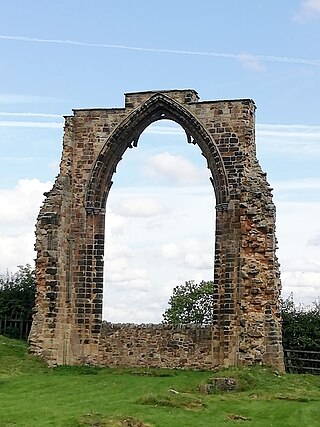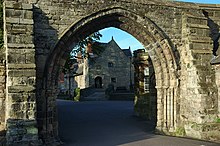
Calke Abbey is a Grade I listed country house near Ticknall, Derbyshire, England, in the care of the charitable National Trust.
Repton is a village and civil parish in the South Derbyshire district of Derbyshire, England, located on the edge of the River Trent floodplain, about 4+1⁄2 miles (7 km) north of Swadlincote. The population taken at the 2001 Census was 2,707, increasing to 2,867 at the 2011 Census. Repton is close to the county boundary with neighbouring Staffordshire and about 4+1⁄2 miles (7 km) northeast of Burton upon Trent.

Repton School is a 13–18 co-educational, private, boarding and day school in the English public school tradition, in Repton, Derbyshire, England.
Wigstan, also known as Saint Wystan, was the son of Wigmund of Mercia and Ælfflæd, daughter of King Ceolwulf I of Mercia.

Willington is a village and civil parish in the South Derbyshire district of Derbyshire, England. The 2001 Census recorded a parish population of 2,604, increasing to 2,864 at the 2011 Census.

Leiston Abbey outside the town of Leiston, Suffolk, England, was a religious house of Canons Regular following the Premonstratensian rule, dedicated to St Mary. Founded in c. 1183 by Ranulf de Glanville, Chief Justiciar to King Henry II (1180-1189), it was originally built on a marshland isle near the sea, and was called "St Mary de Insula". Around 1363 the abbey suffered so much from flooding that a new site was chosen and it was rebuilt further inland for its patron, Robert de Ufford, 1st Earl of Suffolk (1298-1369). However, there was a great fire in c. 1379 and further rebuilding was necessary.

Breadsall Priory is a former Augustinian priory in Derbyshire, situated around two kilometres north of Breadsall, and two kilometres east of Little Eaton. The priory was established before 1266 by a member of the Curzon family. Only a small priory, Breadsall was dissolved in 1536.

Beauvale Priory was a Carthusian monastery in Beauvale, Nottinghamshire. It is a scheduled ancient monument.

John Port Spencer Academy, formerly known as John Port School, is an academy and secondary school in the village of Etwall, Derbyshire, England.

Sir John Port was an English landowner and Knight of the Order of the Bath who served occasionally in the House of Commons. He was Sheriff of Derbyshire in 1554. By his will, he founded Repton School and almshouses at Etwall. He also owned Caverswall Castle from 1531 after acquiring it through marriage to Elizabeth.
Maud of Gloucester, Countess of Chester, also known as Matilda, was an Anglo-Norman noblewoman and the daughter of Robert, 1st Earl of Gloucester, an illegitimate son of King Henry I of England, and Mabel, daughter and heiress of Robert Fitzhamon. Her husband was Ranulf de Gernon, 4th Earl of Chester.

Gresley Priory was a monastery of Augustinian Canons regular in Church Gresley, Derbyshire, England, founded in the 12th century.

King's Mead Priory was a Benedictine Priory situated west of Derby, in the area currently known as Nun's Street, or Nun's Green. It was the only Benedictine Nunnery in Derbyshire.
Repton Abbey was an Anglo-Saxon Benedictine abbey in Derbyshire, England. Founded in the 7th century, the abbey was a double monastery, a community of both monks and nuns. The abbey is noted for its connections to various saints and Mercian royalty; two of the thirty-seven Mercian Kings were buried within the abbey's crypt. The abbey was abandoned in 873, when Repton was overrun by the invading Great Heathen Army.

St Wystan's Church is a Church of England parish church in Repton, Derbyshire that is famous for its Anglo-Saxon crypt which is the burial place of two Mercian kings. The church is recorded in the National Heritage List for England as a designated Grade I listed building, and is dedicated to the Anglo-Saxon Saint Wystan, who was formerly buried within the church's crypt.

Sandleford Priory was a small Augustinian Priory, the remains of which now stand at Sandleford in the civil parish of Greenham in the English county of Berkshire.

Dale Abbey, also known as the Abbey of Stanley Park, was a religious house, close to Ilkeston in Derbyshire. Its ruins are located at the village of Dale Abbey, which is named after it. Its foundation legend portrays it as developing from a hermitage, probably in the early 12th century. After several false starts, it was finally constituted as an abbey in 1204. It was affiliated to the Premonstratensians, an order of canons regular in which it played, at times, a leading part among English Houses. It acquired a large number of small properties, concentrated in areas of the East Midlands, developed a network of granges and appropriated a number of lucrative parish churches. Its discipline and reputation varied considerably, particularly in the 15th century, and it seems to have fallen away from the originally austerity. By 1536 its income was well below the threshold set for the Dissolution of Lesser Monasteries. Although there were accusations of grave immorality, the abbey was allowed to pay a fine to continue its existence until 1538.
The Hundreds of Derbyshire were the geographic divisions of the historic county of Derbyshire for administrative, military and judicial purposes. They were established in Derbyshire some time before the Norman conquest. In the Domesday Survey of 1086 AD the hundreds were called wapentakes. By 1273 the county was divided into 8 hundreds with some later combined, becoming 6 hundreds over the following centuries. The Local Government Act 1894 replaced hundreds with districts. Derbyshire is now divided into 8 administrative boroughs within the Derbyshire County Council area.
Repton is a civil parish in the South Derbyshire district of Derbyshire, England. The parish contains 53 listed buildings that are recorded in the National Heritage List for England. Of these, six are listed at Grade I, the highest of the three grades, one is at Grade II*, the middle grade, and the others are at Grade II, the lowest grade. The parish contains the village of Repton, the smaller village of Milton, and the surrounding area. The major complex of buildings is associated with Repton School, built on the site of an earlier priory. Many of these are listed, four of them at Grade I. The other Grade I listed buildings are St Wystan's Church and the market cross. Most of the other listed buildings are houses, cottages and associated structures, the earlier ones timber framed, and the later ones in red brick. The rest of the listed buildings include farmhouses and farm buildings, bridges, a water management system, a war memorial, and a telephone, kiosk.
















